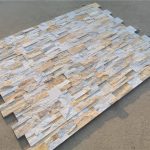The Beauty and Durability of Molded Cultured Stone A Comprehensive Guide

Introduction
In the world of construction and design, the use of molded cultured stone has become increasingly popular in recent years. This versatile material offers a cost-effective and aesthetically pleasing alternative to natural stone, with a wide range of applications in both residential and commercial projects. In this comprehensive guide, we will explore the beauty and durability of molded cultured stone, its manufacturing process, installation methods, maintenance requirements, and the many benefits it brings to the table.

Residential mosaic tile for private properties : Understanding Molded Cultured Stone
Molded cultured stone, also known as manufactured stone veneer, is a man-made material designed to replicate the look and feel of natural stone. It is composed of Portland cement, lightweight aggregate, iron oxide pigments, and other additives that give it its distinctive appearance. Molded cultured stone is cast in molds that are created from real stone to ensure a high level of authenticity in its texture and shape.
One of the key advantages of molded cultured stone is its versatility. It comes in a wide range of colors, shapes, and textures, allowing for endless design possibilities. Whether you prefer the rugged look of fieldstone, the classic elegance of limestone, or the modern appeal of stacked stone, there is a molded cultured stone option to suit your aesthetic preferences.
Chapter 2: The Manufacturing Process
The manufacturing process of molded cultured stone involves several steps to ensure a high-quality end product. The first step is to create molds from real stone pieces that capture every detail and texture of the original material. These molds are then filled with a mixture of cement, aggregates, and pigments to form the stone veneer.
Once the mixture is poured into the molds, it is vibrated to remove air bubbles and ensure a smooth and consistent finish. The stone veneer is then cured in a controlled environment to allow it to harden and gain strength. After curing, the molded cultured stone is removed from the molds, trimmed to size, and inspected for quality before being packaged and shipped to distributors or retailers.
Chapter 3: Installation Methods
Installing molded cultured stone is a relatively straightforward process that can be done by both professionals and DIY enthusiasts. The first step is to prepare the surface where the stone veneer will be applied. This may involve cleaning the area, applying a moisture barrier, and installing a metal lath to ensure a secure bond.
Next, a mortar mix is prepared and applied to the back of each stone veneer piece using a trowel. The stone veneer is then pressed firmly onto the prepared surface, with mortar joints between each piece to create a seamless look. Once the stone veneer is in place, any excess mortar is cleaned off, and the joints are tooled for a professional finish.
Chapter 4: Maintenance Requirements
One of the key advantages of molded cultured stone is its low maintenance requirements compared to natural stone. To keep your stone veneer looking its best, regular cleaning is recommended to remove dirt, dust, and other debris that can accumulate over time. A mild detergent and water solution can be used for routine cleaning, while stubborn stains or discoloration may require a specialized stone cleaner.
In addition to cleaning, it is important to inspect the stone veneer periodically for any signs of damage or deterioration. Cracks, chips, or loose stones should be repaired promptly to prevent further issues. Sealing the stone veneer with a breathable sealer can also help protect it from water damage, UV exposure, and other environmental factors that can affect its appearance and longevity.
Chapter 5: Benefits of Molded Cultured Stone
Molded cultured stone offers a host of benefits that make it an attractive choice for homeowners, builders, and designers alike. Some of the key benefits include:
1. Cost-Effective: Molded cultured stone is more affordable than natural stone, making it a budget-friendly option for projects with limited funds.
2. Lightweight: Molded cultured stone is lighter than natural stone, making it easier to transport, handle, and install.
3. Versatile: With a wide range of colors, shapes, and textures available, molded cultured stone can be customized to suit any design style or aesthetic preference.
4. Durable: Molded cultured stone is resistant to fading, chipping, and cracking, ensuring a long-lasting and attractive finish.
5. Sustainable: The manufacturing process of molded cultured stone produces less waste and consumes fewer natural resources than quarrying natural stone, making it a more environmentally friendly choice.
Conclusion
In conclusion, molded cultured stone is a versatile and durable material that offers a cost-effective alternative to natural stone for a wide range of construction and design projects. With its realistic appearance, easy installation, low maintenance requirements, and many benefits, molded cultured stone is a popular choice for homeowners, builders, and designers looking to enhance the beauty and value of their properties. Whether you're renovating your home, building a new structure, or simply adding a touch of elegance to your space, consider incorporating molded cultured stone into your design for a timeless and sophisticated look.
